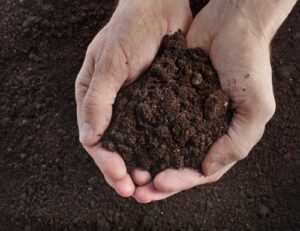The driest inhabited continent on earth. That’s where we Australians find ourselves. And while this fact allows us to enjoy endless days of sunshine on our favourite beaches, the negative is that it means our plant life experiences some truly challenging conditions.
The fact is that the bone dry soil which covers much of Australia isn’t particularly good at sustaining life. This is especially the case if your garden is filled with plants that may be native to the rich soils of Europe or Asia, where rain can be far more forthcoming.
What is a soil wetting agent?
A wetting agent may be the answer to your soil moisture prayers. These agents are surfactants – they work to lower the surface tension between two compounds (liquid water and solid soil particles in this case) which allows the soil to better take in moisture. Certain soils in certain situations can act somewhat hydrophobic, leading to moisture being removed via evaporation. A soil wetter combines the soil and moisture in a deeper way, which makes it more difficult for the moisture to be evaporated away.
Soil wetting agents usually come in a granular form, and can be spread by either hand or a seed spreader. They generally needn’t be mixed into the soil, as they will penetrate it naturally when wet (this may mean that you need to water certain types of soil wetting agent in).
Do I need a soil wetting agent?
The fact that the majority of Australians live near the coast makes this hydrophobicity all the more prevalent, as sandy soils are the worst for retaining moisture. But even the most fertile soils can have issues with taking on moisture, as the breakdown of organic matter can leave a waxy coating on the particles of the soil which repels water. In this situation the soil wetting agent will act as somewhat of a detergent, washing away the waxiness and allowing the soils to take on moisture. Potting mix can have similar waxiness issues, so soil wetting agents can help to make these mixes far more effective.
In Australia soil wetters are best used in the beginning of spring, as the last of the winter rains will help the granules penetrate the soil, preparing it for the coming heat and dryness. If you spread your soil wetter too late in the year it may not be as effective.
Soil wetting agents also have their use in compost heaps. Because the ability to take on moisture affects the breakdown speed of organic matter, your garden debris can turn to compost in far quicker time with the help of a soil wetting agent than it may naturally.
The McKays Restore Granular Soil Wetter
If your soil is sandy or generally hydrophobic, if you’ve found bare and dry patches in your lawn, or if your composting efforts needs a hurry-up, McKays Restore Granular Soil Wetter is about as complete a soil wetting agent as there is. Perfect for areas with minimal rain or water-restrictions, it is one of the best products on the market for the penetration and retention of moisture in soil.
Restore can be spread easily by hand for small garden areas and bare lawn patches, or by a fertiliser spreader for larger areas like parks, golf courses and sports fields. Unlike many other soil wetting agents, restore doesn’t need to be watered in. It will naturally penetrate the soil when rained on or made wet by irrigation. It is visible when applied, ensuring that you don’t miss any areas nor go over any twice. And being a granular soil wetter, you have greater control when spreading. The granules are all of a uniform size, making even spreading a breeze.
Restore Granular Soil Wetter is bought by the kilogram, with 3kg capable of covering an area of 100 square metres. If you have any further queries on whether Restore Soil Wetter is the right choice for you, don’t hesitate to contact the friendly team at McKays!
Does perennial ryegrass come back every year?
Perennial ryegrass is a type of grass that does indeed come back every year. This is in contrast to annual ryegrass, which only lives for one growing season before dying off. Perennial ryegrass is a popular choice for lawns and turfgrass because it is very hardy and can withstand a lot of wear and tear. It is also relatively low-maintenance, requiring only occasional mowing and watering.
How do you care for perennial ryegrass?
Perennial ryegrass is a versatile and hardy grass that is easy to care for. It tolerates a wide range of soils and climates, and is relatively drought-resistant. However, like all grasses, it does require some basic maintenance in order to stay healthy and looking its best.
Mowing is the most important aspect of care for perennial ryegrass. It should be mowed regularly, at least once a week, to keep it from getting too tall. The height of the grass should be kept at around 3 inches. This will ensure that the grass stays dense and lush, and prevents it from developing bare patches.
Perennial ryegrass also needs to be fertilized periodically. A slow-release fertilizer should be applied every 6-8 weeks during the growing season. This will help the grass to maintain its green color and keep it from getting thin and weak.
Finally, perennial ryegrass needs to be watered regularly. It should be watered deeply and evenly, about 1 inch per week. This will help it to develop a deep root system and stay healthy during periods of drought.
How long does perennial ryegrass take to establish?
Perennial ryegrass is a type of grass that is often used for lawns, pastures, and other areas where a grassy surface is desired. It is a fast-growing grass that can establish itself quickly, often in as little as two weeks. Once established, it is a hardy grass that can tolerate a wide range of conditions, from drought to heavy traffic.
What time of year do you plant perennial ryegrass?
Perennial ryegrass is a cool-season grass, which means that it thrives in cooler temperatures and goes dormant in hot weather. In general, you should plant perennial ryegrass between Autumn and Spring, when the temperatures are cool. This gives the grass the best chance to establish itself.
Test
test



